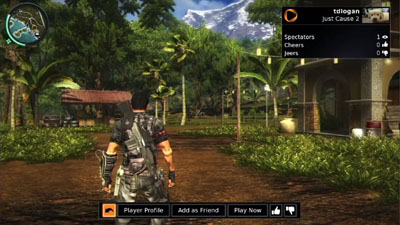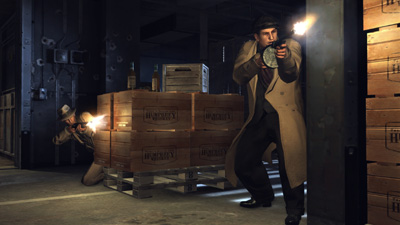Hello.
My name is Robin, and this is my website about computer games. Here you can find essays about old games, industry commentary, free games I've made for fun, and funny songs.
Over the weekend Supermono released a version 1.1 update for Forever Drive, which fixes many of the issues that I outlined in my previous post. From the patch notes:
* You can now report bad tracks from a button and it will be erased from our servers once it has been vetted via email
* You can earn credits by racing lots of tracks and also sometimes as gifts
* 5 free track slots
* You can now EDIT your existing tracks to make it better without the need to purchase more slots
* You no longer boost when crossing a timeline
* New Monorail scenery to add to your tracks
* Help webpage linked from in game, along with a helpful Video to show you why you should get HI COMBOS!
Already there are far fewer broken tracks being served up by the game, suggesting that the developer is acting on email reports quickly. Having to submit reports via email is a bit odd (and I can imagine that some players will have a problem with having to share their email address to use this function), but I suppose the intention is to discourage players from spamming the report button for every track.
Making credits earnable through gameplay is a major improvement. The game still requires a lot of grinding, but there’s now much more incentive to use the complementary credits early on to unlock a better car.
The underlying problem of the game’s economy being based on players ‘gambling’ credits to race on user generated tracks that can include broken tracks made by griefers still persists. Perhaps the next step should be to only include tracks in the Super XP Mode that have a net positive rating, zero (or very few) reports and a minimum number of previous plays (say, 100).
There are still a couple of other intermittent niggles outstanding. If a track ends on a tight curve it’s possible to crash into a wall between tracks (when steering control has been taken away from the player). This should be changed so it doesn’t reset the combo meter.
There’s also the rain. The game will sometimes randomly decide to change the weather conditions for the duration of one track. The wet weather setting massively degrades the car’s handling, making the game more frustrating (and less fun) while offering no compensatory reward. It’s basically a random “game over” button that can cut short your run at any time. It shouldn’t necessarily be removed altogether, but the effect on handling could stand to be toned down a lot.
Overall, though, Forever Drive is now much closer to fulfilling its potential. It’s great to see a developer taking on board user feedback so quickly and comprehensively.
Tags: Forever Drive, freemium, IAP, iOS, iphone, Mario Kart, microtransactions, OutRun, supermono
I’d been looking forward to Supermono’s iOS arcade racer Forever Drive since it was previewed at the World of Love conference in January. So when I heard the other day that not only was it finally out but it was a free download to boot, I didn’t need any further encouragement to check it out.

I’ve put a few hours into it now and I’m afraid to say I’m a bit disappointed. The game’s two major defining features – highly polished, TRON-like cyberpunk visuals and an endless, player-generated race track – are both present and by and large live up to expectations. However there are in my eyes several flaws with the game in its current incarnation, ranging from trivial to fundamental. Instead of just moaning about it, I’ve decided to go through the flaws as I see them one by one and try to figure out how they can be fixed in future updates of the game.
The catalyst that made me decide to sit down and write this was Adam Saltsman’s strongly worded article on Gamasutra where Forever Drive is singled out as a game which incorporates the “freemium” business model in a particularly unsatisfactory way, and some of the (dismissive and frankly a bit haughty) responses that this drew from people who interpreted it as an attack on all freemium/free-to-play games.
Forever Drive’s developer has stated that they put a lot of work into making the game’s freemium elements as unobtrusive as possible, and I have no reason to doubt that. I would charitably assume that the game’s problems in that area are more a result of the developer’s unfamiliarity with the model and a difficulty to see their game with fresh eyes, rather than cynical greed.
Tags: Forever Drive, freemium, game title, IAP, iOS, iphone, Mario Kart, microtransactions, OutRun, supermono
Yesterday the first details of the industry’s worst kept secret, ‘Project Redlime’ – a.k.a. Starbreeze’s ‘reimagining’ of the Bullfrog classic Syndicate – started to dribble out onto the global infoweb.
The scant information that has been revealed – a product description and some screenshots – has been met with howls of derision from people who played and loved the original game, which in turn have been met with grunts of condescension from people under 30 for whom Starbreeze may as well be adapting the films of Harold Lloyd.
I had (perhaps naively) hoped that Starbreeze would be a ‘safe pair of hands’ for a project like this. The main things that I know about their games is that they tend to be visually distinctive and to attempt things a few steps outside of the FPS norm. My faith was rather shaken by the leaked materials, which seem to depict the most generic militaristic near-future FPS imaginable, a mess of Killzone, CoD and FEAR.
It is of course entirely possible that the actual game isn’t going to be a Modern Warfare knock-off, and EA have just cherry-picked information that suggests that it is, to reassure the large portion of their audience for whom CoD defines action games. The emphasis on co-op play and mention that there are levels based on missions from the original give a glimmer of hope.
But there are also hints that the meddling with the Syndicate concept runs much deeper. You will, apparently, be playing the role of an autonomous character (“Miles Kilo”) – a syndicate agent rather than an executive overseer. There are mentions of personal motivations (“revenge”), and, oddly, of civilians being able to choose between Syndicates.
This makes me worry that the game is going to be about a syndicate agent going rogue, and potentially acting in the interests of the people and against the interests of the syndicate, in a dorky white-knuckle spy thriller plot. (Or in other words plundering liberally from Deus Ex.) Syndicate wasn’t about that.
Syndicate was as bleak and unambiguous as anything Bullfrog ever produced. I’m sure it’s been talked up in the past (by Gillen probably) as being an unconscious synthesis of the value system of Thatcher’s Britain. It works because it rationalises the amoral actions of your agents as being justified by money and power, with the assuredness of a teenager who has grown up on 2000AD, Robocop and Blade Runner. (Sean Cooper was only 20 when he programmed the game.)
(As for the commentators scoffing at EA’s use of the word ‘visceral’, that’s absolutely what Syndicate was. Most of the appeal of the game was in the feedback the player got from wreaking havoc in a populated city. I’m surely not the only person who would scour each map annihilating every person, car and tree long after the mission had been completed.)
If Starbreeze (or any modern developer) want to try to truly recreate Syndicate (rather than just plundering the basic premise and name recognition) they walk a tightrope between making it a game where you’re actually the good guy, or one where you’re an exaggeratedly obnoxious pantomime villain, almost as an inevitable consequence of modern AAA action games ‘needing’ to have voiced plot-advancing character-driven cut-scenes.
Even if it does turn out to be terrible, there are at least some other games that explore the same ground. Deus Ex: Human Revolution (which I should get around to writing about properly at some point) essentially has you playing a syndicate agent (albeit drawn from the company ranks rather than grabbed off the street), and has all the cybernetic augmentations, biochips, steam grates and neon that one could wish for. (Even if you don’t care a fig about Syndicate you should go and buy it anyway, because it’s excellent.)
Droid Assault (recently overhauled in anticipation of its imminent Steam release) plays rather like an abstract, cutesy version of Syndicate, where ‘capturing’ enemies (persuadertron-style) has an even more pronounced strategic dimension. (Incidentally, it’s a bit worrying that the Syndicate description makes no mention of the persuadertron.)
Going further back, Freedom Fighters gave a good demonstration of how A.I. squad-based, block-by-block guerilla warfare could work in a ‘modern’ game (although it has aged quite poorly).
Looking forward, the great thing about the success of Deus Ex: HR is that it has suddenly made cyberpunk-themed games a commercially viable proposition again, so perhaps we’ll see more games that capture something of Syndicate’s atmosphere, even if the ‘official’ one doesn’t.
Tags: bullfrog, commentary, cyberpunk, deus ex human revolution, ea, pc games, sean cooper, starbreeze, syndicate
Given the transient nature of mobile games it might be useful to occasionally take a snapshot of the games I currently have in rotation (in a ‘New Games’ folder on the first page of my iPhone’s menu).
Even from this tiny sample it’s possible to see how many iOS games that until recently would have been sold as premium apps have moved to the free-to-play model. Some of the games using this model don’t even feature ads in the free version, depending solely on in-app purchases for revenue.
In terms of content, there’s the usual mix of rich, console-style games and simple microgames. Both approaches are valid, and confound attempts to encapsulate a single ‘correct’ formula for designing and marketing smartphone games.

The indie game that seems to have generated the most buzz over the last few weeks (helped in no small part by the tireless PR efforts of co-creator Andrew J Smith) is Spilt Milk Studios’ Hard Lines. A minimalistic mash-up of Snake, Tron’s light cycles and Geometry Wars’ art style, Hard Lines features six distinct playing modes, all of which involve guiding your single-pixel-wide line (Lionel) by swiping in the desired direction, collecting ‘shiny bits’ and avoiding crashing into walls and AI-controlled enemy lines.
What could have been quite a dry and generic game is infused with charm by the fact that all the lines are constantly spouting lines… of dialogue! (Ahem.) There seem to be hundreds of these lines, culled from loads of obscure sources. (Be sure to play the ‘Snake’ game mode, where the line tells jokes and stories as you progress, and listen to the credits song.)
The controls are nice and responsive (negotiating tight corners and slipping your line through narrow gaps is as satisfying as in every other snake/tron game), but the game is slightly marred by the speed with which it can detect swipes (noticeably slower than a d-pad), and slight frame-rate hitches when multiple enemies are spawned. There doesn’t seem to be any Game Center support either, although presumably it’s imminent.
(more…)
Tags: Berzerk Ball, Berzerk Studio, Coin Drop, Coin Push Pro, Death Rally, Fullfat Games, game title, Hard Lines, iOS, iPad, iphone, ipod touch, Magnetic Billiards, mobile games, Pickford Bros., Poppy, Quiz Climber, Relentless, Remedy, Spilt Milk Studios, X-Baseball
It’s difficult to make long-term predictions about the future direction of the games business. We can try to estimate how technology will advance based on past trends, but there’s no way to predict the inventions that will be implemented with that technology, and which of those inventions capture the public’s imagination. One thing that we can safely say is that even when a new development becomes a phenomenal success, games are such a broad medium that the impact will still be effectively localised. Social games for instance, while a billion-dollar industry at this point, have barely registered on the fortunes of traditional PC and console games.
At the moment there is a lot of buzz around the idea of ‘cloud gaming’, as defined by OnLive and Gaikai. OnLive, who have sunk fantastic sums of money into developing (and patenting) real-time video compression technologies, view ‘cloud gaming’ as the ultimate form of DRM. Their prospectus is designed to appeal to the (sadly often accurate) popular caricature of a games publisher: frantically paranoid about the threat of piracy, and resistant to adapting their existing content creation methods to the specific strengths and weaknesses of a new platform. (Consumers and developers, by comparison, seem to factor into OnLive’s plans as little more than incidental.)
Gaikai have a more pragmatic strategy, acknowledging the inherent shortcomings of ‘dumb terminal’ cloud delivery (image compression, lag, bandwidth consumption and congestion) and focusing on integrating their technology into publisher’s websites to allow download-free demos, instead of selling or renting full games. (Note that I haven’t investigated Gaikai as closely as OnLive purely because they’ve not made as much conspicuous noise. Their model might be quite different to how I’ve described it, and might have pros and cons that have escaped my notice.) There are also a number of other companies touting similar technologies, such as OTOY and iSwifter.

What OnLive would like to see (or perhaps, what they need to happen to justify their investment to date) would be for client-side gaming to go away entirely. Obviously this isn’t going to happen. Even if the technology and broadband infrastructure improves over the next decade (and let’s be clear here: right now, OnLive’s offering is only even an option for a tiny niche, and even they must be willing to overlook its shortcomings compared to playing the same games on a $199 console or $499 PC), there will be games that are simply more practical to implement either fully locally (games on mobile devices need to be resilient to network dropouts), or as a more sophisticated remote/local hybrid than just booting up a virtual copy of a DVD game at a server farm somewhere.
(more…)
Tags: cloud, cloud gaming, commentary, gaikai, hype, jonathan frakes, onlive, predictions, scepticism

As some of you may have guessed, I’m a huge id Software fan, as a result of spending countless hours playing (and sometimes modding) their games over the last twenty years, and appreciating the vast amount of technical innovation they’ve achieved to the benefit of the industry as a whole. They’ve not always been the only guys innovating in particular areas, but, like Sega in the arcades, they’ve done a lot of the heavy lifting.
As id’s releases have slowed in recent years, ceding the limelight to the likes of Valve, Epic and Blizzard, there has been a worrying trend to downplay their historical significance. The cynic in me (i.e., me) thinks that even if their forthcoming game Rage turns out to be an amazing return to form it still won’t reverse the trend, as the narrative has already been set: id/Carmack have the gall to treat games as cold, emotionless engineering challenges, so it’s not possible that the end result can succeed as entertainment as well. (“You may think you’re having fun, but, SIGH, you’re just shooting things…”)
With the launch of Rage fast approaching, we can expect gaming’s many dimwits to dutifully drag out the usual hoary old cliches about id and their games. If you feel the urge to join in, remember you don’t have to have seen or played any of the games in question – in fact, if you were too young or simply exclusively focused on console games when Doom and Quake came out, you have all the more reason to be irrationally dismissive about one of the most important and influential development studios ever.
Here we go:
(more…)
Tags: brown, commentary, doom, Id Software, john carmack, monster closets, pedantry, quake, rage, rant, stupidity, tech demo, wolfenstein
Yesterday I attended the fourth GameCamp event, held at London South Bank University’s Keyworth Centre.
As with the previous GameCamps I attended (2008, 2010), the event was organised following the ‘unconference’ model. Attendees were free to book any one of fifteen rooms throughout the day in 30 minute slots, to talk about (or play) anything they wanted.
As there were around 300 attendees – twice that of any previous GameCamp – some logistical issues arose with the venue. Most of the rooms could only accommodate 20-30 people tops, and signposting, movement between rooms, access to refreshments, ventilation, etc. were sources of frustration.
In spite of these problems, the event was able to deliver the expected mix of highly informative and varied sessions, although the continued attrition of ‘big name’ attendees since the first GameCamp resulted in there being fewer true stand-outs.
I won’t write up blow-by-blow accounts of each talk I attended here – as my notes weren’t very thorough, and this wouldn’t take into account conversations I had (and games I played) between sessions and after. You can see the whiteboards of the even schedules here: Morning, Afternoon (courtesy of Dr. Mike Reddy).
I attended the Game Literacy/Facebook, Sex!, Structure vs. Freeplay, Narrative Debate, Flash Game Design & Business, Dialogue Trees, Fail States, Awesome Flash Games (my session), and Post Mortem sessions, and poked my head into a few others. Board and card games again had a strong presence, and I got to play The Resistance and Once Upon a Time in the bar afterwards.
The central info-hub of photos, notes and impressions is here: http://gamecamp.org.uk/2011/05/15/this-was-a-triumph/
Below are some additional notes on my talk, as promised.
(more…)

A while ago I finally caved and bought the shiny, voiced, HD remake of Monkey Island 2: LeChuck’s Revenge on Steam. The recent round of Q&As and interviews with the Portal 2 writing team (where they reveal that the writers actually cued up the recorded voice performances in the game themselves, to ensure that the comedic/dramatic timing worked as intended) has reminded me about it, and the specific reasons in which I think LucasArts unfortunately screwed it up.
(TANGENT: If you haven’t played Monkey Island 2 before, I would strongly recommend playing the original DOS version of the game through SCUMMVM before the Special Edition. Also, I’m only referring to the PC version of the Special Edition here. The quality varies widely between platforms. The iOS port in particular is almost unplayable – omitting the developers’ commentary, bonus galleries and even the intro, trashing the classic mode’s graphics, making dialogue unskippable and failing to support task switching – glaring flaws which almost all iOS reviewers ignored. A low price doesn’t excuse shoddy work, especially when compared to the polish evident in similar remakes, such as Broken Sword. TANGENT ENDS.)
I approached this remake with some trepidation. Monkey Island 2 is my favourite of all the SCUMM games, and involves substantially more complexity and subtlety than any of its predecessors. LucasArts’s previous attempt at reviving a SCUMM game (the original Secret of Monkey Island) was a disaster. The new artwork was sloppy, seemingly only included to meet console marketing requirements, and couldn’t be switched off without also disabling the voice acting. It was rushed out and it showed.
In fairness, a lot of things work well in the sequel. The animation is smoother without looking out of place. The new backgrounds are attractive and in keeping with the tone of the original game. There are still a few areas where incongruous Sam & Max / DOTT-style chunky cartoon geometry creeps in, but on the whole the backgrounds are a vast improvement over the MS Paint travesties of the first Monkey Island remake.
(more…)
Tags: game title, lucasarts, monkey island, monkey island 2, PC Gaming, rants, scumm

Minotaur Rescue (a.k.a. “Solar Minotaur Rescue Frenzy”) is Llamasoft‘s (i.e. Jeff Minter’s) first game for iOS. It’s available as a universal app which natively supports iPhone and iPad device configurations. The game is part of the “Minotaur Project“, a series of games modelled after the design sensibilities of different eras of computer hardware, but unbounded by the cost and technology-driven limitations of the real hardware of the time.
Minotaur Rescue purports to be a game made for the fictional “Ataurus TVC 2605”, a device which has the graphical output of an Atari VCS, the text overlay of a Commodore VIC-20, and the ability to render a seemingly unlimited number of sprites, particles and feedback effects without slowdown, thanks to Llamasoft’s NEON engine.
The gameplay is most easily described as a mash-up of Asteroids and Space War. The player pilots a small, constantly-firing triangular ship around a toroidal area of space (i.e. a single screen which wraps at the X and Y boundaries).
The ship is controlled via an ingenious ‘virtual trackball’ interface. Gently stroking anywhere on the touchscreen sets the heading and acceleration of the ship. This allows for rapid lunges across the screen as well as more subtle steering. I expect that other top-down iOS games will quickly adopt this input method.
(more…)
Tags: Asteroids, game title, iOS, iphone, Llamasoft, Minotaur Rescue, mobile games, Space War, YaK
Yesterday, the second ‘World of Love‘ indie games development conference was held at Conway Hall in Bloomsbury.
The day was packed with interesting talks from developers with disparate approaches and levels of experience. Participants brought practical advice and anecdotes, inspiring calls to action, and willy jokes. Here’s a run-down of the day’s events:
Ricky Haggett and Richard Hogg of Honeyslug talked about the process of developing their forthcoming game Hohokum. The game was probably already familiar to most of the crowd (having been previously shown at the Indie Games Arcade at the Eurogamer Expo last year), but this presentation gave a run through of the various forms the game has taken over the past three years or so (shooter, platformer, golf game, etc.), and to the process by which the duo have decided which ideas to explore and which to cut.
One fact-nugget that seemed to resonate was the idea that ‘playful’ messing around in a game is only fun if there’s a ‘proper’ task the player is wilfully ignoring by choosing to muck about. No release date for Hohokum was mentioned but it can’t be far off now, surely.
Next up was Tak Fung of Supermono, developer of MiniSquadron and Epic Win for iPhone. Tak seems to have taken a similar path to other ex-major studio employees like Cliff Harris and the Hello Games team, but pointed out that by gradually weaning himself off dependence on contract work he was able to make the transition to full-time indie while managing the level of risk. It’s impressive that a team of two guys (Fung and artist Dave Ferner) have managed to release two successful games in just over two years.
Third on stage were Ella Romanos and Martin Darby of Remode Studios, best known for their casual downloadable game Mole Control. They discussed how to go about setting up a studio / digital agency from a purely pragmatic business perspective. Useful fact: it’s apparently very easy to get R&D tax credits.
(more…)
Tags: conference, dark wind, honeyslug, indie, mode 7, pc games, preloaded, remode, rock paper shotgun, supermono, world of love
Earlier in the week we finally hit the big scary launch button on Isoball, the iOS/Android puzzle game that I’ve been producing at Zattikka for the last few months. You can get the lowdown in the launch press release, and versions for iPhone/iPad Touch, iPad and Android are now available on their respective App Stores.
We’ve also done Lite versions for iPhone and iPad. (The Lite version is 10 levels which can be completed fairly quickly – the remaining 40 levels in the full game ramp up the difficulty significantly, and include new blocks like conveyors, bridges and teleports. In playing time terms the Lite version represents considerably less than one fifth of the full game.)


The smartphone game is based on the Flash game Isoball 2 by Candyflame, and was ported by Eclipse Interactive up in Manchester. Hats off to both of these teams – Candyflame for coming up with such an ingenious design in the first place, and Eclipse for adapting it to the particular quirks of each target platform.
But that’s not all! We’ve also just released Isoball 3 on Flash, which has 75 new levels and generally beefs up the presentation and feature set of Isoball 2.
This is all pretty exciting! And I would of course be eternally grateful if, should you have any interest in puzzle games and a suitable device, you could download and rate Isoball. It’s only £0.59 ($0.99) on iPhone, that’s less than 1p per level (including the bonus levels).
Merry Yulesmas, games-chums!
Tags: android, game title, games i've done, iphone, ipod touch, isoball, isoball 3, mobile games, puzzle, smartphone, zattikka
A few weeks ago I was made aware of this Kickstarter project. (Which has since been launched.) For those who can’t be bothered to read and watch all that, in a nutshell, ‘Gameful’ is a not-for-profit initiative started by Jane McGonigal and associates intended to give funding and support to games projects – but not just any games projects, those that are deemed to be “reality-changing, life-changing, game-changing or world-changing”.
Now, I’m aware that I might come across as a contrarian arse to criticise a project that seems to be completely well-meaning and benign, but a few things about it stick in my throat.
1. Entertainment is a dirty word. The misguided utilitarian philosophy behind the (failed) serious/persuasive games movement looms large over Gameful’s mission statement. Work in any artistic medium does not have a social responsibility to be edifying. The assertion that “entertainment” is a mindless activity and cannot include ideas that go on to have any utility in a broader context unless they’ve been explicitly put there is both dead wrong and impossibly patronising.
Even the most crassly commercial games are made by skilled, emotionally complex human beings with the conscious goal of capturing the player’s interest and provoking a response. I strongly suspect that a lot of the rhetoric against ‘mainstream’ games comes from people who exclusively or predominantly play WoW – certainly McGonigal’s examples involving ‘games’ are heavily weighted toward it. Sitting down with a few games that have more narrative and simulation complexity and nuance than Tolkien’s Biggest Ever Skinner Box (I’d suggest starting with Ultima IV and working towards Machinarium, Bioshock 2, etc.) would quickly disabuse them of this belief.
(more…)
Tags: commentary, elitism, gameful, jane mcgonigal, nonsense, rant

Before we can get down to discussing the long-awaited second installment in 2K Czech’s rich-simulation crime saga, we must first clear up a piece of mindless vandalism. I am referring of course to Eurogamer’s catastrophically mishandled review, penned by freelancer John “Who?” Teti.
The review shows the downside of Eurogamer’s freelance review policy. Their reviewers have the liberty of interpreting both their remit and the site’s scoring system as they see fit (making attempts to statistically analyse their scores pointless). Giving complete free rein to a reviewer can yield stunning results when the writer has extensive experience and is willing to take the task seriously. Sometimes the results can be polarising, but at least it’s possible to glean a coherent picture of why the reviewer came to their conclusions. In the hands of a dismal amateur, hell-bent on shaping their shallow critique around faulty preconceptions about the developer and publisher, it’s a loaded gun.
Teti has decided (against the evidence of playing the game or its predecessor) that 2K Czech are cynical, barely-literate jerks, and that the game’s refusal to cater to his remedial tastes must be their fault rather than his. To service this fiction he magnifies the game’s flaws and invents a host of new ones. He spends most of his time petulantly whining that the game isn’t fun if you try to play it like GTA. He describes the quality of the writing as “[having] a systemic disdain for the English language”, when Bill Harris (a writer who Teti could learn a great deal from, from tying his shoelaces upward) holds the view “The first 13 chapters were, bar none, the finest writing I’ve ever seen in a game”. Gosh, who to believe?
I could go through Teti’s bullshit hatchet job line by line, but it would just be tedious (and anyway forumite Monkichi – again, a calm, measured, non-histrionic voice with infinitely more credibility than Teti can ever hope to achieve – has already saved me the trouble). It’s puzzling that the editor who commissioned the piece (shot through as it is with factual errors and cheap, baseless attacks) didn’t question it.
Anyway, that’s far more attention than Teti’s ineptitude warrants, so on to the game.
(more…)
Tags: 2k czech, game title, mafia, mafia ii, PC, rant, storytelling
As you have probably seen by now, it’s been revealed that PC Zone magazine is set to close, going out with a (hopefully) triumphant farewell issue, to be edited by stalwart OXM editor Jon Hicks.
I’m slightly surprised that I’ve never written anything on this blog about PC Zone, a magazine which I took for over a decade from its launch in 1993, and which was my favourite games magazine for much of that time.
All the eulogies of the magazine that I’ve seen have dwelt on a handful of controversies that occurred during a ‘Maxim-esque’ phase of the magazine’s life in the late 1990s (coverdisk porn, joystick-groping nuns, banned cartoon strips and prank phonecalls, the latter two being the work of a pre-media-moguldom Charlie Brooker, whose moderately successful stint at the magazine has predictably gained a legendary status).
Conventional wisdom has it that PC Zone was more puerile and lightweight than the more respectable PC Gamer. There’s a grain of truth in this, but the laddish reputation tends to overshadow the fact that PC Zone contained a lot of very good, innovative and influential writing.
(more…)
Tags: commentary, magazine, mr cursor, PC, pc zone, retrospective

Spurred on by the success of earlier UK indie game jams (including this one), Ricky “Honeyslug” Haggett, Terry “VVVVVV” Cavanagh and co. organised a weekend jam to coincide with Pixel-Lab’s World of Love indie development conference. In spite of my continued insistence that I can’t program, I went along, and even made a couple of (fairly awful) games. Over two dozen other gaming enthusiasts also showed up, including Eskil Steenberg and Kieron Gillen.
You can read my rather whimsical report on the event at Honeyslug’s site.
You can play the game I made as well as everyone else’s at Cambridge Friendship Club.
But please, do not play Vegetable Game.
Tags: Frozen Lake Folk Duo Reunion, gamejam, games i've done, london, Vegetable Game, world of love
